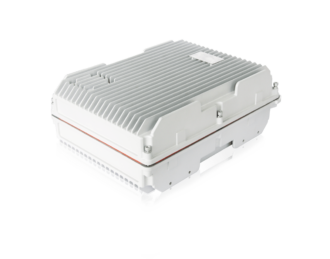Outdoor PON aggregation remote side unit
AN-PON-AGG-R is the outdoor PON aggregation extender developed by AD-Net. It supports 1+1 dual power backup (AC220V/DC48V optional), suitable for extreme environment. AN-PON-AGG-R supports for holding pole installation. Adopting NMS3000 network management platform, AN-PON-AGG-R is with strong management capability and user-friendly interface, supports in-band network management, rapid configuration and setup for easy network maintenance and management.
|
Parameters |
AN-PON-AGG-R |
|
Device Dimensions (mm) |
285 (W) * 380 (D) * 144 (H) |
|
Power supply |
DC -48 / -60V or AC 110 ~ 220V (optional) |
|
Installation Method |
Hanging pole |
|
The maximum number of wavelengths |
2 |
|
Service slots |
1 |
|
Single-channel maximum rate |
10Gbit / s |
|
Cross particle |
ODU1 ODU2 |
|
Optical fiber interface |
LC / UPC SC / UPC |
|
Transmission fiber |
G.652 G.653 G.655 |
|
Protection mode |
Device level protection: 1 + 1 power backup |
|
Transmission technology |
CWDM (G.694.2) 2.5G /10G line rate |
|
Electrical cross |
Fixed rate crossing based on ODU1 / ODU2 port |
|
Network topology |
Point to Point |
|
Features |
Description |
|
Basic function |
Supports general management on SC card. Supports configuration management, alarm management, performance management, fault management etc. for PAE service card. Supports in-band management? Supports out-band DCN. Supports processing and forwarding synchronization information internally. Supports 8-channel GPON / EPON aggregation. Supports multiplexing / de-multiplexing between PON signal and ODU2. GPON mode: supports 4 x GPON signal multiplexed into 1 x OTU2, up to 8 x GPON signal generated into 2 x OTU2 per card; The OTU2 interfaces are independent. EPON Mode 1: supports 8 x EPON signal multiplexed into 1 x OTU2 EPON Mode 2: supports 4 x EPON signal multiplexed into 1 x OTU2, up to 8 x EPON signal generated into 2 x OTU2 per card; The OTU2 interfaces are independent. |
|
OTN function |
Supports PM, SM overhead processing on the line-side interface, support TTI. Supports scrambler and descrambler. GPON: 2.5G<->ODU1<->ODU2<->LINK EPON: 1.25G<->2.5G<->ODU1<->ODU2<->LINK Support FEC G709. |
|
Line protection |
GPON mode: supports 1+1 protection for 4 x GPON signals. EPON Mode 1: do not support line protection. EPON Mode 2: supports 1+1 protection for 4 x EPON signals. |
|
PON port -processing |
Support 3R function for PON port. |
|
GPON <->ODUk mapping |
Downlink: supports alarm monitor for GPON OLT downstream interfaces on client side; supports ODU1 de-mapping for GPON downstream signals on ONU side. Uplink: supports alarm monitor for GPON ONU upstream interfaces on client side; supports 1.244G <->ODU1 mapping on ONU side. Supports overhead processing for PM layer. |
|
EPON <-> ODUk mapping |
Downlink: supports alarm monitor for EPON OLT downstream interfaces on client side; supports ODU0 de-mapping for EPON downstream signals on ONU side. Uplink: supports alarm monitor for EPON ONU upstream interfaces on client side; supports 1.244G <->ODU0 mapping on ONU side. Supports overhead processing for PM layer. |
|
ODUk GCC function |
GPON Mode: supports 2 independent GCC0. EPON Mode 1: supports 1 GCC0. EPON Mode 2: supports 2 independent GCC0. |
|
PON proxy |
GPON mode: supports GPON range proxy, supports GPON leading compensation. EPON mode: supports EPON idle compensation. |
|
PM and alarm monitoring |
Supports alarm monitoring and alarm management, such as alarm suppression, alarm reversal, alarm shielding, and so on. Supports PM and PM monitoring, such as zero suppression performance, current performance, and historical performance and so on. |
|
Optical transceiver management |
Supports DDM. Supports hot swap. |


Scenario 1: for the local-side OLT centralized management, point-to-point network. The local PAE has a lot of PON Ports need to aggregation extension to the remote, the remote-side also requires a large number of PON port for PON network.

Scenario 2: Applicable to the local OLT centralized management, Local-side has a lot of PON Port at the end of the aggregation extension to the remote-side. Data traffic is relatively small, and more decentralized. The distant end has to have an indoor room.

Scenario 3: Suitable for the local-side OLT centralized management, requires much PON port aggregation. The remote data traffic is relatively small, and more decentralized, no indoor room, it can only be installed in the outdoor environment.

Scenario 4: applies to the central office PON port is relatively small, point to point network, It can be aggregated far to the far end.

Scenario 5: Suitable for point-to-point network,the local-side needs to be aggregated far PON port is relatively small, no remote indoor room, need to be installed outdoor
| AN-PON-AGG-R | Outdoor PON aggregation remote side unit |
Description
AN-PON-AGG-R is the outdoor PON aggregation extender developed by AD-Net. It supports 1+1 dual power backup (AC220V/DC48V optional), suitable for extreme environment. AN-PON-AGG-R supports for holding pole installation. Adopting NMS network management platform, AN-PON-AGG-R is with strong management capability and user-friendly interface, supports in-band network management, rapid configuration and setup for easy network maintenance and management.

